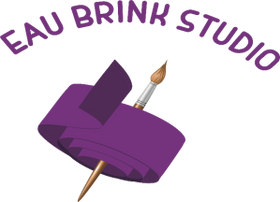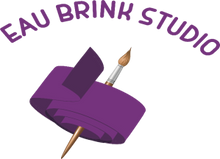Stitching Stories: From Slow Hands to Digital Thread
After spending hours layering fabric, stitching textures, and adding beads to capture that quiet, grey day at sea, you’d think the story would end there.
But in my studio, some pieces have second lives.
Once the final stitch is in and the threads are tied off, I don’t always put the work away. Instead, I sometimes begin a new process entirely—one that feels part magic, part engineering. And that’s exactly what happened with this piece.
From Handmade to Digital Thread
I photographed the finished embroidery, making sure to capture the colour and line as clearly as possible. Then came the transformation: I vectorised the image using software that translates shapes and stitch paths into a cleaner, simplified version that can be read by my embroidery machine.
This step always feels like translating between languages—one of fabric and freeform movement, and one of precision and programming.
Once the vector file was ready, I converted it into a JEF file, compatible with my machine. And then… I watched it all come alive again.
199 Thread Changes and a Few Snapped Nerves
Watching the machine stitch out the design was oddly thrilling—but also a test of patience and trust. This particular piece required 199 thread changes. That’s not including the several threads that snapped mid-stitch and had to be rethreaded and coaxed gently back into motion.
It’s part of the process. It’s fiddly. It’s time-consuming. And yet—it’s also deeply satisfying. Each thread change marks a shift in colour, tone, or texture—a moment that contributes to the final image taking shape.
The hum of the machine. The dance of the needle. The slow reveal of something already familiar, but now made new.
The Joy of Dual-Making
What I love about this approach is that it bridges two worlds. One is slow, tactile, intuitive—layering organza and cotton, adjusting thread tension as I go, letting the fabric decide how it wants to fall. The other is technical, precise, structured—turning imagery into code, feeding it into the machine, and letting automation do its work.
The final result is a stitched pair: one created by hand, full of unique texture and spontaneity; the other a clean, repeatable embroidery that captures the spirit of the original. Both tell the same story from different voices.
Nearly There…
All that’s left now? Snipping off all the thread bands—those little linking strands that run between sections—and framing it.
It’s a quiet moment, a finishing ritual that signals the end of a long, satisfying process. Holding the finished piece in my hands, seeing the transformation from photo to fabric to digital stitch—it reminds me why I return to this process again and again.
Why It Matters
For me, this dual process is more than technical play—it’s about expanding what textile art can be. It's about sharing work in new ways, repeating designs that are meaningful, or turning them into pieces that can be worn, framed, gifted, or even turned into kits for students.
It also honours the full journey of a piece—from the first inspiration by the sea to the final pass of the machine needle.
Coming Soon: A Limited Stitch Edition?
I’ve started to wonder if certain works—like this one—should exist in both forms: one original, one stitched edition via machine. Perhaps a limited run of stitched artworks, each signed and numbered, could allow more people to hold a part of the story in their hands.
Let me know what you think. Would you be interested in collecting a machine-stitched version of an original artwork?





Leave a comment